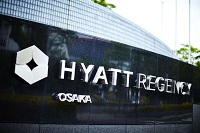Venue & Hospitality
Conference Venue:
Hyatt Regency Osaka
1 Chome-13-11 Nankokita,
Suminoe Ward, Osaka,
Osaka Prefecture 559-0034,
Japan
Accommodations will be provided at
1. Hyatt Regency Osaka
1 Chome-13-11 Nankokita,
Suminoe Ward, Osaka,
Osaka Prefecture 559-0034,
Japan
2. Osaka Marriott Miyako Hotel
Kintetsu Miyako Hotels International, Inc.
1-1-43, Abenosuji, Abeno-Ku, Osaka 545-0052 JAPAN
Conference Dates: October 18-19, 2017
Hotel Services & Amenities
- Audio/Visual Equipment Rental.
- Business Center.
- Business Phone Service.
- Complimentary Printing Service.
- Express Mail.
- Fax.
- Meeting Rooms.
- Office Rental.
- Photo Copying Service.
- Secretarial Service.
- Telex.
- Typewriter.
- Video Conference.
- Video Messaging.
- Video Phone.
- ATM.
- Baggage Storage.


Transportation
Driving Directions to
From Kansai International Airport to the Hotel
Located at Izumisano city, Kansai International Airport is conveniently accessible via limousine airport bus, taxi, Hotel limousine car and train.
Limousine Airport Bus
The limousine airport bus departs from Bus Stop 3 on the arrivals floor of the airport. Take the bus bound for Osaka Nanko for JPY1,550 per person. The first bus departs at 09:10am and the last bus departs at 9:10pm. Travel time is approximately 50 minutes.
Please click here for timetable.
Taxi
A direct taxi ride from the airport to the Hotel would cost approximately JPY14,000 per car (4 persons maximum ). The travel time is approximately 45 minutes depending on traffic.
Note: this is the most convenient way to reach the Hotel outside the operating hours of the limousine bus service.
Hotel limousine car
Hotel limousine takes approximately 45 minutes depending on traffic and costs JPY16,000 per car per trip. Advance reservation is necessary via our Concierge department via email atconcierge.osaka@hyatt.com.
Train
Go to the Nankai line and catch the train to Namba. This part of the journey takes approximately 50 minutes. Transfer to the red subway line “Midosuji” and catch the train to Umeda station. Look for the JR Osaka exit then proceed to the Hotel shuttle bus stop by taking the Sakurabashi exit.
This bus service to the Hotel runs daily from 8:30am to 10pm, every 30 minutes and travel time is approximately 25 minutes. Total travel time is approximately 2 hours.
Please click here to see subway map.
*First train departs at 05:45am and the last train departs at 11:59pm.
Note: For travel from the airport after 9pm, go to the Nankai line and catch the train to Namba.
Exit the station completely and catch a taxi to the Hotel. Approximate cost is JPY5,000 JPY per car (4 persons maximum ) and travel time is approximately 30 minutes.
Route Map
About City
Japan is an island nation in the Pacific Ocean with dense cities, imperial palaces, mountainous national parks and thousands of shrines and temples. Shinkansen bullet trains connect the main islands of Kyushu (with Okinawa's subtropical beaches), Honshu (home to Tokyo and Hiroshima’s atomic-bomb memorial) and Hokkaido (famous for skiing). Tokyo, the capital, is known for skyscrapers, shopping and pop culture.
Japan is a stratovolcanic archipelago of 6,852 islands. The four largest are Honshu, Hokkaido, Kyushu and Shikoku, which make up about ninety-seven percent of Japan's land area. The country is divided into 47 prefectures in eight regions. The population of 126 million is the world's tenth largest. Japanese people make up 98.5% of Japan's total population. Approximately 9.1 million people live in the core city of Tokyo,[10] the capital city of Japan, which is the sixth largest city proper in the OECD and the fourth leading global city in the world.[11] The Greater Tokyo Area, which includes Tokyo and several surrounding prefectures, is theworld's largest metropolitan area with over 35 million residents and the world's largest urban agglomeration economy.
Japan is a leading nation in scientific research, particularly technology, machinery and biomedical research. Nearly 700,000 researchers share a US$130 billion research and development budget, the third largest in the world.Japan is a world leader in fundamental scientific research, having produced twenty-two Nobel laureates in either physics, chemistry or medicine, and three Fields medalists.Some of Japan's more prominent technological contributions are in the fields of electronics, automobiles, machinery,earthquake engineering, industrial robotics, optics, chemicals, semiconductors and metals. Japan leads the world in robotics production and use, possessing more than 20% (300,000 of 1.3 million) of the world's industrial robots as of 2013—though its share was historically even higher, representing one-half of all industrial robots worldwide in 2000
In Japan, health care is provided by national and local governments. Payment for personal medical services is offered through a universal health insurance system that provides relative equality of access, with fees set by a government committee. People without insurance through employers can participate in a national health insurance program administered by local governments.
